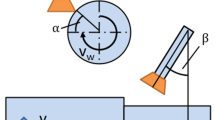Abstract
The turning operation using a self-propelled rotary tool (SPRT) is efficient manufacturing for hard machining. However, optimization-based energy saving of the rotary turning has not presented because of expensive implementation. This study addresses a parameter optimization to enhance the machining rate (MR) and decrease the energy consumption (ET) as well as the machined roughness (R) for a hard turning using SPRT. The process inputs are the inclined angle (α), depth of cut (a), feed rate (f), and cutting speed (V). The hard turning runs were performed using the experimental plan generated by the Taguchi approach. The adaptive neuro-fuzzy inference system (ANFIS) was used to construct the correlations between the process inputs and responses. The analytic hierarchy process technique was adopted to explore the weight values of the outputs, and the optimum solution was obtained utilizing the adaptive simulated annealing. Moreover, an integrative approach using the response surface method and utilizing the desirability approach was employed to select the optimal outcomes and compare with the proposed technique. The findings revealed that the proposed ANFIS models minimize the predictive error in comparison with the traditional one. The accurate weights may help to select reliable optimal results. The optimal values of the α, a, f, and V are 18°, 0.15 mm, 0.40 mm/rev, and 200 mm/min, respectively. Moreover, ET and roughness are decreased by 50.29% and 19.77%, while the MR is enhanced by 33.16%, respectively, as compared to the general process.



















Similar content being viewed by others
References
Armarego EJA, Karri V, Smith AJR (1994) Fundamental studies of driven and self-propelled rotary tool cutting processes-I. Theoretical Investigation. Int J Mach Tools Manuf 34(6):785–801. https://doi.org/10.1016/0890-6955(94)90059-0
Kishawy HA, Wilcox J (2003) Tool wear and chip formation during hard turning with self-propelled rotary tools. Int J Mach Tools Manuf 43(4):433–439. https://doi.org/10.1016/s0890-6955(02)00239-0
Dessoly V, Melkote SN, Lescalier C (2004) Modeling and verification of cutting tool temperatures in rotary tool turning of hardened steel. Int J Mach Tools Manuf 44(14):1463–1470. https://doi.org/10.1016/j.ijmachtools.2004.05.007
Kishawy HA, Becze CE, McIntosh DG (2004) Tool performance and attainable surface quality during the machining of aerospace alloys using self-propelled rotary tools. J Mater Process Technol 152(3):266–271. https://doi.org/10.1016/j.jmatprotec.2003.11.011
Wang SH, Zhu X, Li X, Turyagyenda G (2006) Prediction of cutting force for self-propelled rotary tool using artificial neural networks. J Mater Process Technol 180(1–3):23–29. https://doi.org/10.1016/j.jmatprotec.2006.04.123
Li L, Kishawy HA (2006) A model for cutting forces generated during machining with self-propelled rotary tools. Int J Mach Tools Manuf 46(12):1388–1394. https://doi.org/10.1016/j.ijmachtools.2005
Ezugwu EO (2007) Improvements in the machining of aero-engine alloys using self-propelled rotary tooling technique. J Mater Process Technol 185(1–3):60–71. https://doi.org/10.1016/j.jmatprotec.2006.03.112
Kishawy HA, Pang L, Balazinski M (2011) Modeling of tool wear during hard turning with self-propelled rotary tools. Int J Mech Sci 53(11):1015–1021. https://doi.org/10.1016/j.ijmecsci.2011.08.009
Suzuki N, Suzuki T, An R, Ukai K, Shamoto E, Hasegawa Y, Horiike N (2014) Force prediction in cutting operations with self-propelled rotary tools considering bearing friction. Procedia CIRP 14:125–129. https://doi.org/10.1016/j.procir.2014.03.033
Thellaputta GR, Raju CS, Bose PSC, Rao CSP (2017) Adaptive neuro fuzzy model development for prediction of cutting forces in milling with rotary tools. Mater Today Proc 5(2):7429–7436. https://doi.org/10.1016/j.matpr.2017.11.414
Rao TB, Krishna AG, Katta RK (2015) Modeling and multi-response optimization of machining performance while turning hardened steel with self-propelled rotary tool. Adv Manuf 3:84–95. https://doi.org/10.1007/s40436-014-0092-z
Nguyen TT, Mia M, Dang XP, Le CH, Michael SP (2020) Green machining for the dry milling process of stainless steel 304. Proc Inst Mech Eng B 234(5):881–899. https://doi.org/10.1177/0954405419888126
Alizadeh A, Yousefi S (2019) An integrated Taguchi loss function-fuzzy cognitive map-MCGP with utility function approach for supplier selection problem. Neural Comput Appl 31:7595. https://doi.org/10.1007/s00521-018-3591-1
Gabi D, Ismail AS, Zainal A, Zakaria Z, Abraham A (2018) Orthogonal Taguchi-based cat algorithm for solving task scheduling problem in cloud computing. Neural Comput Appl 30:1845. https://doi.org/10.1007/s00521-016-2816-4
Sreedhara BM, Rao M, Mandal S (2019) Application of an evolutionary technique (PSO-SVM) and ANFIS in clear-water scour depth prediction around bridge piers. Neural Comput Appl 31:7335. https://doi.org/10.1007/s00521-018-3570-6
Basarir H, Elchalakani M, Karrech A (2019) The prediction of ultimate pure bending moment of concrete-filled steel tubes by adaptive neuro-fuzzy inference system (ANFIS). Neural Comput Appl 31:1239. https://doi.org/10.1007/s00521-017-3108-3
Dey S, Mukhopadhyay T, Adhikari S (2017) Metamodel based high-fidelity stochastic analysis of composite laminates: a concise review with critical comparative assessment. Compos Struct 171:227–250. https://doi.org/10.1016/j.compstruct.2017.01.061
Karsh PK, Mukhopadhyay T, Dey S (2018) Stochastic dynamic analysis of twisted functionally graded plates. Compos B Eng 147:259–278. https://doi.org/10.1016/j.compositesb.2018.03.043
Shastri AS, Nargundkar A, Kulkarni AJ, Sharma KK (2020) Multi-cohort intelligence algorithm for solving advanced manufacturing process problems. Neural Comput Appl. https://doi.org/10.1007/s00521-020-04858-y
Mohammed H, Rashid T (2020) A novel hybrid GWO with WOA for global numerical optimization and solving pressure vessel design. Neural Comput Appl. https://doi.org/10.1007/s00521-020-04823-9
Bera AK, Mukhopadhyay T, Mohan PJ, Dey TK (2017) A multi-attribute decision making approach of mix design based on experimental soil characterization. Front Struct Civ Eng 12:361–371. https://doi.org/10.1007/s11709-017-0425-7
Funding
This research is funded by the Vietnam National Foundation for Science and Technology Development (NAFOSTED) under Grant Number 107.04-2020.02.
Author information
Authors and Affiliations
Corresponding author
Ethics declarations
Conflict of interest
The author(s) declared no potential conflicts of interest with respect to the research, authorship, and/or publication of this article.
Additional information
Publisher's Note
Springer Nature remains neutral with regard to jurisdictional claims in published maps and institutional affiliations.
Rights and permissions
About this article
Cite this article
Nguyen, TT. An energy-efficient optimization of the hard turning using rotary tool. Neural Comput & Applic 33, 2621–2644 (2021). https://doi.org/10.1007/s00521-020-05149-2
Received:
Accepted:
Published:
Issue Date:
DOI: https://doi.org/10.1007/s00521-020-05149-2




